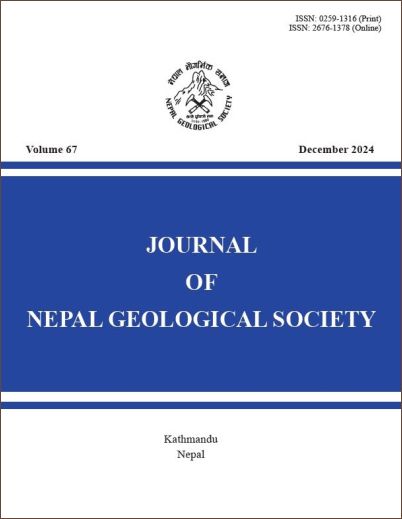Superposed remanent magnetization and magnetic fabric in Triassic carbonates of Tethys Himalaya (Jomsom area, Nepal): chronological and tectonic implications
DOI:
https://doi.org/10.3126/jngs.v67i1.74590Keywords:
Magnetic Fabric, Magnetic Susceptibility, Carbonates, Pyrrhotite, Secondary Magnetization, Tethys Himalaya, TriassicAbstract
Carbonates from three sections in Tamba Kurkur and Mukut Formations near Jomsom in Nepal were investigated for natural remanent magnetization (NRM) and anisotropy of magnetic susceptibility (AMS). NRM comprises up to three components: a recent field component (RF) residing on magnetite/maghemite (soft coercivity: <10-15 mT) and goethite (low unblocking temperature range (Tub): <150°C), a pyrrhotite-based characteristic remanence (ChRMpyr; intermediate Tub: 180-350°C); and another based on magnetite (ChRMmag; high Tub: 400-600°C). In situ ChRMpyr, with northerly declination and steep downward inclination (average value: 58.2°, steeper than the RF (48°) by 8-13°), is linked to thermochemical processes caused by low-temperature metamorphism at or after ca. 30 Ma. Mean CHRMpyr is steeper than the expected inclination by 24°, implying to post-acquisition tilting. Bedding-tilt corrected ChRMmag from Tamba Kurkur Formation is considered primary because of (i) steep negative inclination (-54.1°) implying acquisition at ca. 35°S latitude during the Triassic, and (ii) similarity to the known primary directions from Jomsom and adjacent areas (e.g., Manang, Shiar, Dolpo). Carbonates exhibit low mean magnetic susceptibility (km = 0.7-25.8×10-8 m3kg-1) contributed by diamagnetic and paramagnetic minerals. Magnetic fabric with low degree of anisotropy (PJ <1.12) and diverse ellipsoid shapes (-0.89 < T < 0.92) is a composite of several directional patterns. Discrimination of AMS data by specific ranges of scalar parameters (km, PJ and T) and comparison with mesoscopic structures reveals patterns linked to sedimentary-compaction, metamorphic and tectonic processes/phases.
Downloads
Downloads
Published
How to Cite
Issue
Section
License
© Nepal Geological Society




